Are your product sales on Etsy dwindling?
Are you having difficulty ranking within the top 3 pages of the search results?
In fact, have you ever made it to page 1?
If you sell a great product on Etsy but don’t rank well in search results, it’s most likely a result of a poorly optimized product page.
So before you give up on earning a reputable income on Etsy, follow my SEO guidelines to help you finally reach your well-earned position on page 1 of the search results!
Get ready to be wowed by this incredible Etsy SEO guide.
Let’s get started.
Searching on Etsy is like searching on any other search engine – specific keywords yield specific results.
You need to use keywords that help you rank at the top of the result listings and accurately describe your product.
Why is that important?
If a searcher clicks on your result then clicks out of it and buys another item, it is a strong signal to the Etsy algorithm that your item did not meet their specifications.
The buyer’s purchase specifications can be found in the search query that was used to find your item.
So if nobody purchases your item when the query “fluffy dog toy” is searched, Etsy will assume that those keywords are not descriptive of your item and therefore push you lower in the results list.
Before I teach you how to find your golden nugget keywords, you must first understand the type of keywords you need to look for.
There are generally two types of search queries:
1) Long search queries (long-tail keywords) – these yield the most targeted results.
For example
“When is the best time to drink coffee?”
2) Short search queries (short tail keywords) – these produce broad/general results.
For example:
“Coffee health benefits”
Although long-tail keywords are more targeted, they generally do not have as high a search volume as short-tail keywords.
And though short tail keywords have a high search volume, they do not produce targeted results.
So what should you do?
To have the best chances of ranking your product well in Etsy, you need to use a combination of short-tail and long-tail keywords in your listing title.
Let me give you an example of what this will look like.
Let’s say you are selling this dog toy:

A short tail description of this dog toy would only consist of 1 – 2 primary words such as:
- Dog Toy
A long-tail description of this toy would consist of 3 – 4 primary words:
- Handmade Plush Duck Toy
- Soft Plush Duck Toy
- Fluffy Baby Duck Toy
If I was to use a combination of the above query types to create a listing title, it might look something like this:
“Handmade Push Duck Toy / Soft Plush Duck Toy / Dog Toy / Puppy Toy”
As a general rule, use 1 -2 short tail keywords and 4 – 6 long-tail keywords, to make up the 140 character Etsy title limit.
There is no need to write a complete sentence; you can simply separate each keyword type with a forward slash “/” or a comma “,”
I would suggest that you use a slash to sperate your keywords rather than a comma, it will make your title much simpler to read.
It’s really up to you in terms of the order, although if you have the longer tail keywords towards the front of the title, it will make your product more appealing.
Here is a live example of this strategy in action.
Take a look at the second organic result for the term “dog toy” (ignore the first row they are promoted ads):
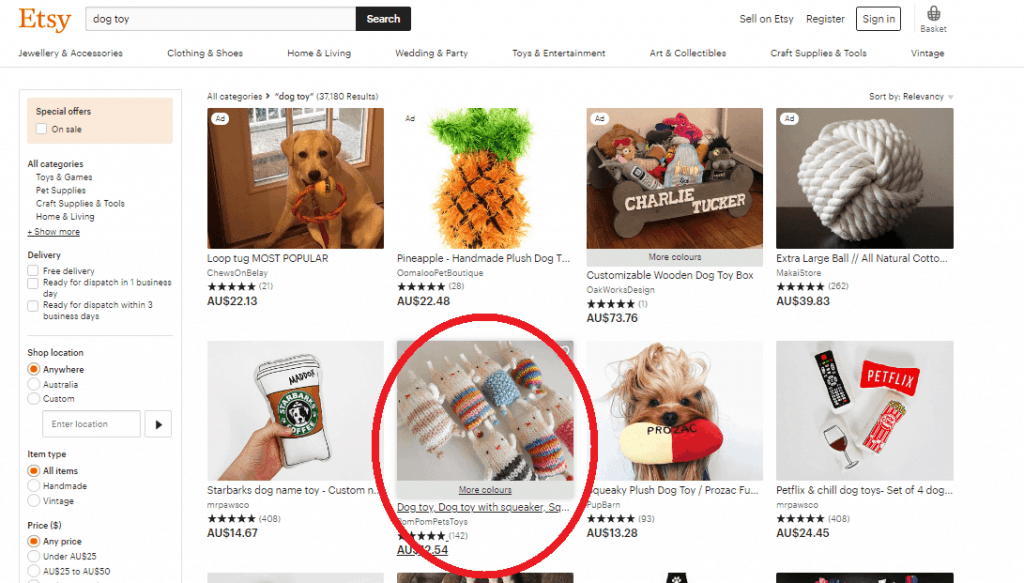
Notice the combination of short-tail keywords (dog toy, small dog toy, etc.) and long-tail keywords (Dog toy with a squeaker, gift for dogs, etc.) in the title of this item:
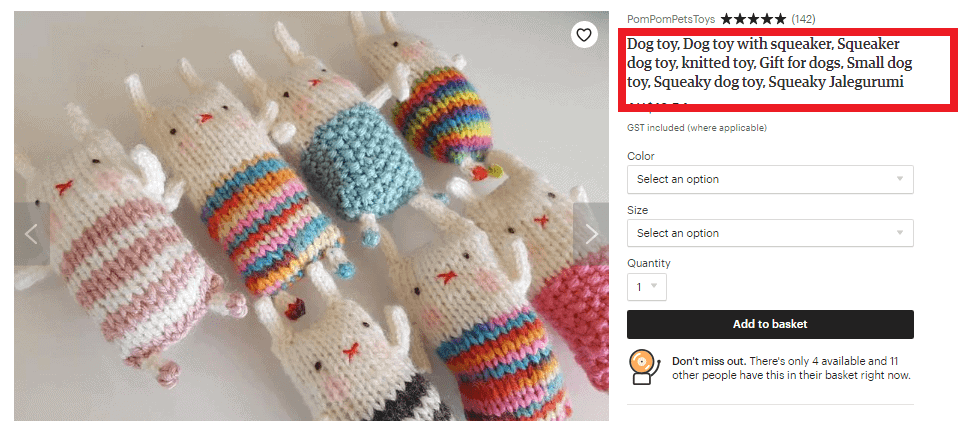
Also, notice how separating each keyword with a comma makes the titles difficult to read – they should have used a forward slash.
Keywords Research
Now that you understand how to structure your keywords in your title, it’s time to actually find your keywords using a keyword research tool. Here are some of the best SEO tools that will help transform your Etsy store.
Keyword research tools provide data-driven proof of the actual search statistics of any given keyword.
Any successful SEO strategy needs to be driven by data-backed evidence.
Never choose a keyword-based on an assumption of its search volume, if you want to make the most of your Etsy listing, you need to ensure that it is 100% optimized at the time of posting.
There are free keyword research tools available, such as Google keyword planner.
But the problem with these free tools is that they are not specifically designed for the Etsy search database, so they do not provide accurate results.
The best keyword research tool that’s specifically designed for Etsy is Marmalead.
You need to pay a monthly subscription to use all of Marmalead’s features, but it is very much affordable at only about $19 per month.
You can trial their software for free by clicking here.
Once signed into the Marmalead platform, you can begin your keyword research.
For consistency let’s stick with the ducky dog toy item above.
Start by searching for the most basic short tail keyword for your item – in our case “dog toy.”
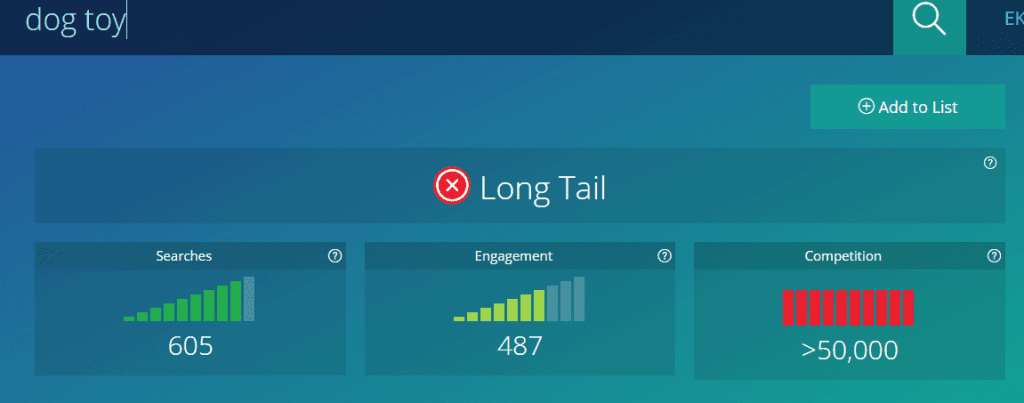
You may notice the incredibly high competition for this search query (over 50,000 listings!)
At this stage that should not phase you because we are purposely searching for a highly competitive keyword to give us a starting point to work from.
If you scroll down the page, you will eventually see a list of long-tail alternative keywords – great stuff!
If you click on the “searches” column, you will arrange these long-tail queries by search volume:
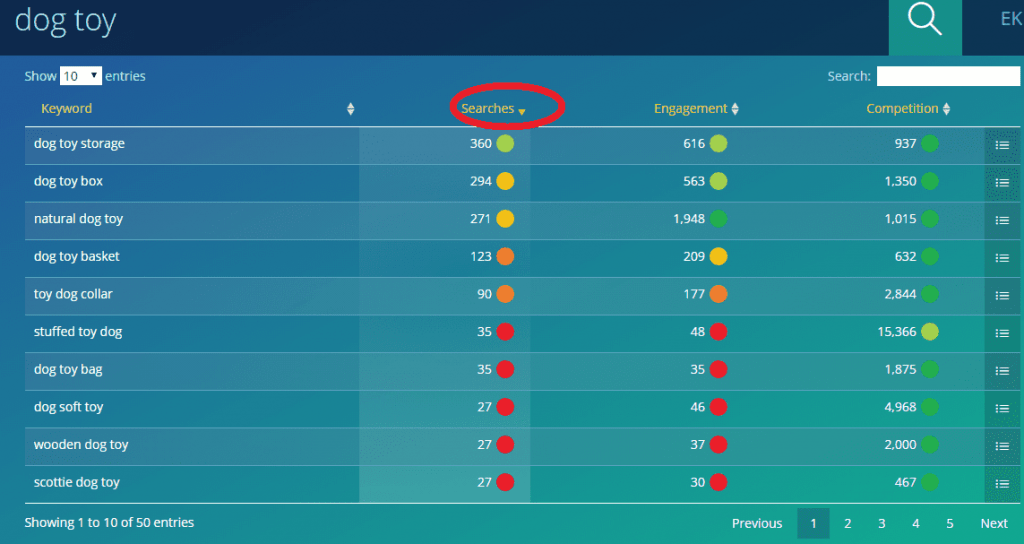
So now you’ve got a great data-backed list of long-tail keyword ideas you can use alongside the short tail keyword “dog toy.”
On the far right is the “competition” column which shows the listings for each keyword.
Ideally, you will choose the long tail keywords with as high a search volume and as low a competition value as possible – so aim for the keywords that correspond to green or orange dots.
In saying that, there is no harm in choosing 1 or 2 red dot keywords within your title, especially if you don’t have many options to choose from.
When choosing keywords from this list, keep in mind and try to focus on the ones that are as descriptive of your item as possible.
If I was to choose some long-tail keywords from the list in the screenshot above for our ducky toy I would choose the following:
- Natural dog toy
- Stuffed dog toy
So now we have the following information to work with:
Short tail keywords:
- Dog toy
Long-Tail Keywords:
- Natural dog toy
- Stuffed dog toy
Let’s find a new short tail keyword to search to find more long-tail keywords.
But what short tail keyword should we use next?
On the same results page for “dog toy” scroll until you reach the section titled “Similar shopper searchers”
This will show a list of search suggestions based on the query “dog toy”
Look, here is a great relevant short-tail search option – Plush toys!
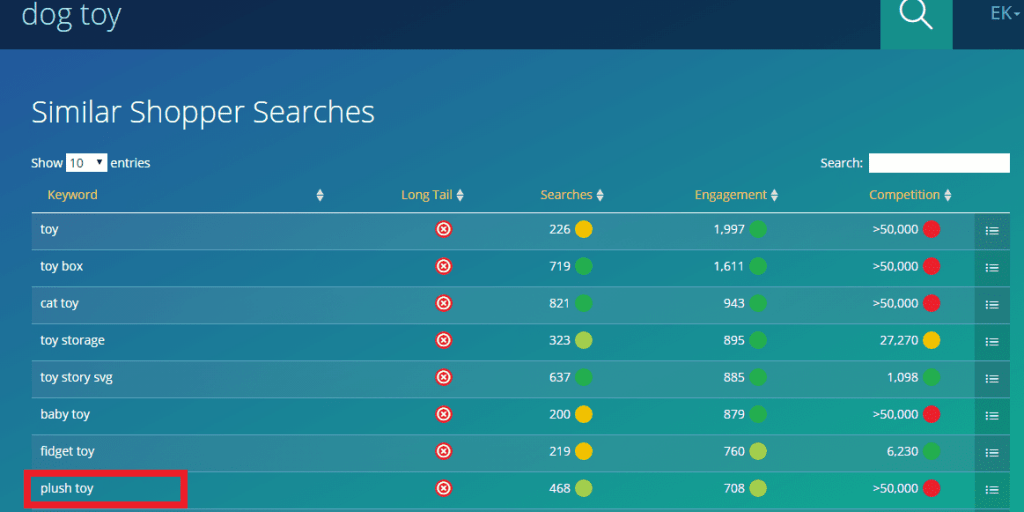
Let’s search “plush toy” to see if we get any good long-tail keyword ideas:
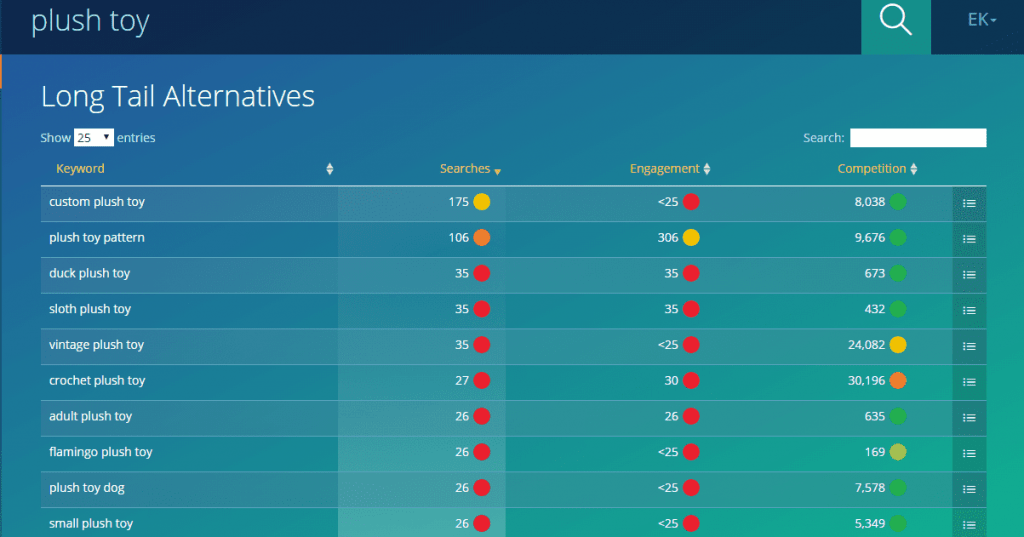
Look at all of these great long-tail keywords that accurately describe our item!
- Custom plush toy
- Duck Plush toy
- Plush toy dog
- Small plush toy
So far, we have the following information to work with:
Short tail keywords:
- Dog toy
- Plush toy
Long-Tail Keywords:
- Natural dog toy
- Stuffed dog toy
- Duck Plush toy
- Plush toy dog
- Small plush toy
We now have enough information to compile a title:
Duck Plush Toy / Stuffed Dog Toy / Plush Dog Toy / Natural Dog Toy / Small Dog Toy / Dog Toy / Plush Toy
Whenever you want to check the search volume of a particular keyword just simply type it into the search bar and click search.
The best keyword choices have a high engagement score (indicated with green colored bars).
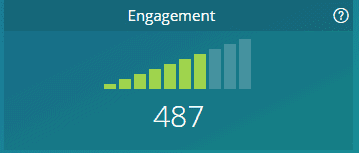
The engagement of a keyword is the expected amount of unique visits that keyword will generate.
Note: Do not feel discouraged if all of your keyword searches that describe your item yield low search volumes and low engagement scores, remember you are combining different keywords, so collectively you should have a high enough search volume.
Lets recap:
- Think of a short tail description of your item – e.g. dog toy.
- Type it into the marmalead search engine and note down all the long tail keyword suggestions that relate to your item.
- Aim to choose long-tail keywords with a high search volume and a low competitor count (orange and green dots) although if your options are limited choose the “red dot” results.
- Under the section “similar shopper searchers” find a new short-tail keyword.
- Search that new short tail keyword and note down all of the relevant long-tail keyword variations.
- Compile a list of about 1 – 2 short term keywords and 4 – 6 long-tail keywords until you have reached the 140 title character limit.
- Use all of these keywords in your listing title separated by a slash. Aim to place the short-tail keywords towards the end of your title to focus on relevancy and descriptiveness.
Product Tags
Choosing the right tags for your Etsy item is imperative to help you rank on the first search result page.
Choosing the right tags is much easier than you think.
In fact, after you have chosen your title keywords, you will have all of your tags ready – your tags are an exact replication of your title keywords!
The order of the tags does not matter.
Here is an example of all the corresponding tags I would use for our ducky toy Etsy title:
Etsy Title:
Duck Plush Toy / Stuffed Dog Toy / Plush Dog Toy / Natural Dog Toy / Small Dog Toy / Dog Toy / Plush Toy
Etsy Item Tags:
Duck Plush Toy | Stuffed Dog Toy | Plush Dog Toy | Natural Dog Toy | Small Dog Toy | Dog Toy | Plush Toy
If any of your keywords are too long to be used as a tag, try to shorten them while remaining as true to their original meaning as possible.
For example:
“Chewable dog teething toy” could be shortened to “dog teething toy”
Use Keywords in Description
In the description of your item, you will need to use each of your chosen keywords at least once.
But make sure the description sounds natural and not ‘keyword stuffed”
The Etsy algorithm (like all search engine algorithms) punishes spammy looking content by pushing them to the bottom of the search result list.
Get As Many 5 Star Ratings As Possible
Think about it; the owners of Etsy want to achieve as many customer transactions as possible.
Therefore, the search algorithm will aim to push the best and highest selling products to the top of the results list.
How will Etsy know that your product is amazing?
With a 5 star rating!
Make a note in your description for buyers to leave a rating, or contact each individual buyer to ask them to submit a rating.
Drive Traffic to your Page
The more traffic you can drive to your page, the stronger your page’s signal is in high demand.
Create social media accounts associated with your Etsy shop, build a following, then drive traffic to your Etsy pages whenever you launch a product.
If you have a website that generates organic traffic, you can create blogs to accompany each of your Etsy products and include links to them.
A great strategy is to entice influencers with a high number of followers to send traffic to your Etsy page.
How do you do that?
Start by finding an influencer within your niche on social media.
For our example of plush dog toys, we might target a doggy groomer or a doggy school.
Feature them in some posts and tag them.
Make sure you put some effort into your featured posts and write a detail caption convincing your followers to use their services.
After a few posts send them a personal message asking them to share a post of yours that links to your Etsy page (if this is on Instagram your Instagram profile will contain a link to your Etsy page, you will then just ask them to tag you in a post).
What makes this strategy so effective is the fact that you are giving incredible value BEFORE asking for a small favour.
If you apply this strategy to multiple influencers, you can drive A LOT of free traffic to your Etsy page and earn some incredible SEO points.
Keep your Etsy Page Fresh
My final SEO tip is to keep your shop fresh and up to date.
The Etsy algorithm favours updated entries because it’s a strong indication that the products are in stock.
You can achieve this by either consistently adding new items or manually renewing your old items regularly.
Aim to NEVER let your items expire.
Renewing an existing item is super easy:
After you have logged into Etsy, click on “shop manager” and then click “listings.”
Select all the items you would like to renew then click on the renew button at the top of the page.
Voila, your items are now fresh on the shelves in Etsy’s eyes!
Conclusion.
Keep in mind that SEO takes time, so do not feel discouraged if your ranking does not improve overnight.
But if you follow my Etsy SEO guidelines, the Etsy algorithm will eventually notice you and WILL reward you.
Remember, Etsy takes a small percentage of each of your sales, so they are on your side and want you to be as successful as possible.
Prove to Etsy that you are playing by their rules and they will ensure you get as many customers as possible.
To your Etsy Success!
Notice: Trying to access array offset on value of type null in /home/drhidden/domains/pearllemon.com/public_html/wp-content/plugins/wwpforms/includes/class-frontend.php on line 136








